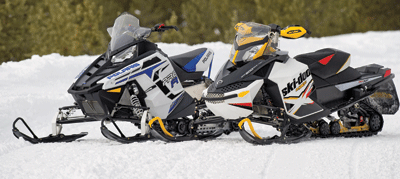In the playground game King of the Hill, it seems it was always the biggest, heaviest kid who would plant himself atop the snowpile while all of the smaller kids took runs at him to try to knock him off. Some of the smaller kids may have even considered lifting weights and bulking up to try to make a run at him.
In the real-life world of snowmobiling, things work quite the opposite.
In 2011, Polaris’ Pro-RMK models reclaimed the top spot in the mountain market with a chassis that was lighter and more nimble than its competition. The company’s marketshare in the segment exploded as riders in the West moved in waves back toward the historic RMK brand that ruled the steep-and-deep market a decade earlier. Polaris seemed destined to dominate again.
The competition took notice. Arctic Cat launched its ProClimb chassis last year, Yamaha offered a turbo option and this year Ski-Doo took a mighty swing at the Pro-RMK by launching the XM chassis and innovative tMotion rear suspension for 2013.
The problem is the target for which they aimed keeps moving.

For 2013, Polaris unveiled an even lighter, more capable and more high-tech RMK. The top-of-the-line 800 Pro-RMK weighs in at just 417 pounds, claimed, with a 155-inch track or 424 with a 163-inch track, making it more than 40 pounds lighter than its nearest competition. To shed 14 pounds this year, Polaris engineers turned to structural bonding in the front suspension, a carbon-fiber overstructure for the base chassis, stiffer and lighter running boards, a smaller seat and, most notably, a new twist to the sled’s drive system that makes this sled better.
Polaris engineers worked with Gates to create the first belt-driven system on a mass-produced snowmobile. Dubbed the QuickDrive Low Inertia Drive System, the setup utilizes nickel-plated pullies, an extruded-aluminum drive shaft and a carbon-core belt with upgraded polymers to strip 6.5 pounds of rotating mass out of the driveline. The power gets to the track faster, thanks to a 21 percent reduction in rotational inertia. That, in turn, helps make the most mobile production mountain machine ever built even easier to toss around, tip over and hang-off of when sidehilling, playing in powdery meadows or scaling seemingly impossible obstacles. The Pro-RMK is more capable and more fun.
That’s all great news for mountain riders, but there’s good news for trail riders as well: The QuickDrive technology offers benefits that can apply to you as well. Mark our words: This is technology that will spread not just through Polaris’ lineup but throughout the snowmobile world, resulting in a higher percentage of the engine’s horsepower reaching the track on a snowmobile with less weight in the driveline. We truly believe the days of the chaincase are numbered on performance snowmobiles, as the technology introduced on the 2013 Pro-RMK will change expectations in our sport.
The Snow Goer Snowmobile of the Year criteria states that a winning snowmobile should be an “innovative, trendsetting representation of the future, and offer a unique and positive impact on the sport.” We look for trendsetting snowmobiles, benchmark machines upon which people will someday look back and say, “That was the machine that debuted this technology or that feature.”
The 2013 Polaris 800 Pro-RMK does that, and it also just happens to be the best mountain snowmobile available. That makes it our King of the Hill — in the mountains, and in the snowmobile market for 2013.
See 10 more top sleds soon! Don’t want to wait? Find the current issue on newsstands or subscribe now!








How many more years before sdioko figures out how to set up clutches , seriously did you see the belt temps ! This has been a problem with sdioko for 20 years , can’t you find one guy in Canada to figure this out ? Don’t tell me it’s the horse power of the new motor because your 670 and 700 summits were even worse , and no other manf. Has this problem , if you can fix this problem sdioko will rule the roost !!!!